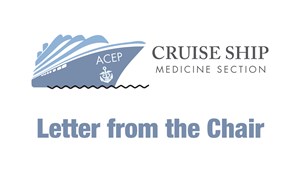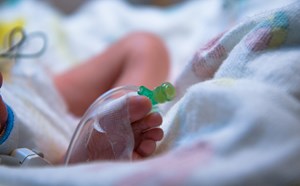
Clinical Case: C-spine Subluxation at Sea
History of Present Illness: It was a dark and stormy September morning after the MS Volendam left Seattle for Hawaii, five sea days away. One of our passengers, a 68 year old gentleman, was taking a shower in his cabin, when he fell as a result of rough seas, striking his head on the sink on the way down. His wife heard the thump and called the Infirmary for assistance. He was not taking any medications that might have precipitated dizziness or vertigo, and he denied any loss of consciousness or antecedent syncopal symptoms. He hadn’t vomited or been seasick. He denied ever having fallen before.
Examination: The patient was awake and alert, GCS 15, with a 4 cm laceration to his right parietal area. Vitals were normal. Fortunately, he was neurologically intact, with 5/5 strength to all proximal and distal muscle groups. Sensory exam was normal. No other injuries to the thorax, abdomen or extremities were noted. The laceration was quickly repaired. When he remarked that he was experiencing significant pain in his neck, the medical team assisted him over to our x-ray room for cervical spine films. The films are below. You can imagine the horror I felt seeing the lateral view, a C–4 on 5 subluxation, particularly knowing that we were already on the Pacific with five sea days stretched out in front of us.
Questions:
- What other management approaches could be considered with an injury such as this in the non-hospital environment with the limited resources of a cruise ship?
- How would your approach change if there was significant neurological deficit?
Management: Deciding that five days on a spinal board was an unreasonable option, we immobilized his neck in a hard collar, and placed him in our ICU bed. In discussions with the Chief Officer and Captain, I learned we were only 158 miles off the Oregon coast. Because this was a life-threatening emergency, I thought that perhaps the US Coast Guard might be able to help us get him safely off the ship. After consulting with their flight surgeon, they agreed to accept the mission and meet us 100 miles off the mouth of the Columbia River. The Captain turned the ship towards the rendezvous point. Luckily, it was still daylight when the helicopter appeared low on the horizon between rain squalls. The deck team cleared a suitable space on the Lido deck aft and the USCG winched down a rescue swimmer to work with the medical and security teams to get the patient into a basket for evacuation to the helicopter. Throughout the transfer, the patient remained neurologically intact. His wife was there providing emotional support. Finally the patient was winched off the deck* and was on his way to Oregon Health Sciences Center in Portland, where he underwent a surgical anterior reduction of the fracture/subluxation and a posterior fusion. Amazingly, he walked out of the hospital three days later and finished his journey back home.
Discussion: This case clearly illustrates how teams from many different departments on a ship need to work together to complete a complicated medevac. A ship’s physician must use many skills to deal with everyone involved so that aviators, bridge and security officers, hotel staff, and medical teams can perform in an integrated fashion. Thankfully, everything went seamlessly and we managed to transport the passenger to definitive care without a spinal cord injury. Without the availability of excellent diagnostic aids and top quality nursing care on the ship the successful outcome of this event would not have occurred.
Please see the article written by the Salem-News, Astoria, Oregon. The video from the helicopter’s perspective is chilling.
*See the video in the web link
http://salem-news.com/articles/september252010/astoria-coastguard-rescue.php
http://www.youtube.com/watch?v=EtTIMQ86HVQ&feature=player_embedded#!
Dr. Schneidman has been an emergency physician for 30 years and a cruise ship physician for more than 10 years with Holland America Line. He is currently the Councillor for the Cruise Ship and Maritime Medicine Section. He lives and practices in the Chicago area.



